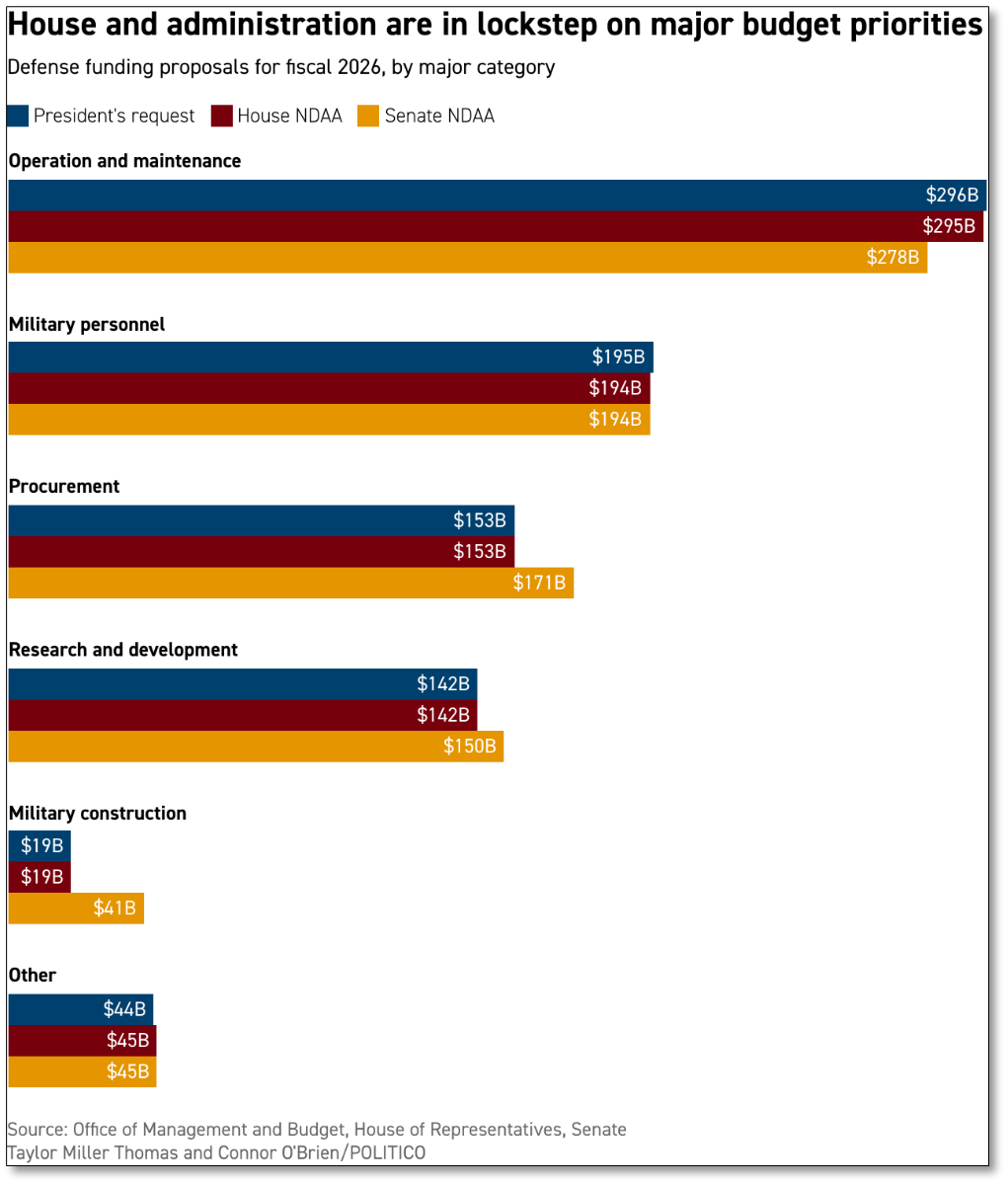Washington Legislative Update: SimTech
UPDATE
Much of the news from Washington is about the government shutdown, now in its 27th day. Below are updates on the National Defense Authorization Act, Appropriations Bills, and excerpts from an article written by my Maynard Nexsen colleague, Lynn Marshall, about the promise of Golden Dome.
DEFENSE
National Defense Authorization Act, Summary/Highlights:
- The National Defense Authorization Act (NDAA), the annual defense policy legislation, is one of the few major bills that becomes law each year. It does not allocate any spending but an indicator of where Congress stands on the defense budget and large defense programs.
- President Trump and Republicans included a one-time defense boost of more than $150 billion in the One Big Beautiful Bill. However, the President wants to otherwise keep the defense budget flat, while GOP defense hawks argue more aggressive spending hikes are needed to modernize the military.
- The House Version of NDAA (H.R. 3838, passed September 10) matched Administration’s Budget of $893B. The Senate version (S. 2296, passed October 9) included $32B in additional spending, for a total NDAA of $925B. House and Senate Leaders are targeting a final compromise bill by the end of the year.
- Two key players in the discussion are Representative Mike Rogers (AL-03), Chair of the House Armed Services Committee, and Senator Roger Wicker (MS), Chair of the Senate Armed Services Committee.
- More information at “Defense Budget” later in the newsletter.
Information from Politico Pro, 10/3/2025, 10/9/2025
FY 2026 Appropriations Bills: Status
Highlighting 5 of 12 Appropriations Bills
Commerce-Justice-Science
- House: House Appropriations Committee passed H.R. 5342 on 9/10/2025. Awaits action by full House.
- Senate: Senate Appropriations Committee passed H.R. 2354 on 7/17/2025. Awaits action by full Senate.
Defense
- House: Full House passed H.R. 4016 on 7/18/2025.
- Senate: Senate Appropriations Committee passed S. 2572 on 7/31/2025. Awaits action by full Senate.
Homeland Security
- House: House Appropriations Committee passed H.R. 4213 on 6/24/2025. Awaits action by full House.
- Senate: Awaits action by Senate Homeland Security Appropriations Subcommittee.
Military Construction-Veterans Affairs
- House: Full House passed H.R. 3944 on 6/25/2025.
- Senate: Full Senate passed H.R. 3944 on 8/1/2025.
State-Foreign Operations
- House: House Appropriations Committee passed H.R. 4779 on 7/23/2025. Awaits action by full House.
- Senate: Awaits action by Senate State-Foreign Operations Appropriations Subcommittee.
GOLDEN DOME
[Excerpts from The Golden Dome for America, Lynn Marshall, August 15, 2025]
What is the Golden Dome for America?
In Executive Order 14186 (E.O.), The Iron Dome for America, President Trump declared on January 27, 2025 that the United States is vulnerable to catastrophic attack by ballistic, hypersonic and cruise missiles as well as by other forms of advanced aerial attacks. The E.O. states that it will be the policy of the United States to “provide for the common defense of its citizens… by deploying and maintaining a next-generation missile defense shield.” To implement this policy, the President orders the Secretary of Defense to submit to the President within 60 days of the date of the order “a reference architecture, capabilities-based requirements, and an implementation plan for the next-generation missile defense shield.” An example of what this architecture must consist of includes plans for:
- Acceleration of the deployment of the hypersonic and ballistic tracking space sensor layer
- Deployment and development of proliferated space-based interceptors capable of boost-phase intercept and development
- Deployment of a secure supply chain for all components with next generation security and resilience features
See, E.O. Sec.3 (a)(ii), (iii) and (vii) respectively.
“The Iron Dome for America” moniker was soon abandoned as it was too closely associated with an entirely different set of capabilities - Israel’s current missile defense system (the Iron Dome).The renamed Golden Dome for America (GD) aspires to detect and intercept hypersonic, ballistic, and cruise missiles, as well as other advanced aerial attacks like drone swarms, from four separate layers surrounding the continental United States, Alaska and Hawaii. These four layers for missile defense are: space, upper, under and at the multi-domain surface referred to as the “limited area defense domain”. The goal is that the GD will detect and intercept based on a 360-degree view of fast-moving, high-altitude, wide geographic radius symmetric and asymmetric threats deploying both kinetic and non-kinetic measures.
Congress, under Public Law No. 119-21 (H.R.1- One Big Beautiful Bill Act, hereinafter “the Act”), in turn appropriated funding to the Department of Defense (DoD) in order to begin the mission. The President has referred to the following appropriations as an “initial deposit” on the Golden Dome. The rough order of magnitude for Golden Dome is $151 billion over ten years, but some experts estimate a price tag over $700 billion to cover development, fielding, maintenance, and sustainment of the new missile defense system. Note that the Act does not specifically identify the Golden Dome for America under the amounts appropriated.
At Sec.20003. Enhancement of the Department of Defense Resources for Integrated Air and Missile Defense of the Act, Congress appropriates $18.8 billion for next generation missile defense. This is the breakdown:
(1) $250,000,000 for development and testing of directed energy capabilities by the Under Secretary for Research and Engineering;
(2) $500,000,000 for national security space launch infrastructure;
(3) $2,000,000,000 for air moving target indicator military satellites;
(4) $400,000,000 for expansion of Multi-Service Advanced Capability Hypersonic Test Bed program;
(5) $530,000,000 for the design and construction of Missile Defense Agency missile instrumentation range safety ship
(6) $7,200,000,000 for the development, procurement, and integration of military space-based sensors; and
(7) $2,550,000,000 for the development, procurement, and integration of military missile defense capabilities.
At Sec. 20003(b), Congress appropriates an additional $5.9 billion for layered homeland defense:
(1) $2,200,000,000 for acceleration of hypersonic defense systems;
(2) $800,000,000 for accelerated development and deployment of next-generation intercontinental ballistic missile defense systems;
(3) $408,000,000 for Army space and strategic missile test range infrastructure restoration and modernization in the United States Indo-Pacific Command area of operations west of the international dateline;
(4) $1,975,000,000 for improved ground-based missile defense radars; and
(5) $530,000,000 for the design and construction of Missile Defense Agency missile instrumentation range safety ship.
The GD is already the largest investment in the nation’s missile defense since the Reagan Administration’s Strategic Defense Initiative of 1983 (commonly referred to as the Star Wars Program). Again, MDA leads the GD mission and is headquartered in Huntsville. The U.S. Space Force is a major stakeholder in executing the GD mission. Congress has already appropriated almost $25 billion for the GD.
Opportunities and Industry Days
MDA has the task of designing, soliciting, evaluating, testing, contracting, executing and coordinating across all MILDEPs and all of industry for the GD. Below are industry opportunities available:
- NOBLE (Nimble Options for Buying Layered Effects)
MAA NOW NOBLE: Missile Defense Agency - Multiple Authority Announcement: offers due through 3/26/2030;
- MDA’s “one-stop shop”: MDA - PartnerWithUs;
- TBD, 2025 Missile Defense Agency Small Business Conference;
- TBD Connecting with MDA Primes;
- February 26, 2026, Match Maker Sessions (Virtual)
Multi-Disciplinary Requirements
The GD requires a vast array of multi-disciplinary (multi-sectoral), multi-generational as well as international expertise.
|
1. Science and Technology (S&T) 2. Research and Development (R&D) 3. Prototyping 4. Studies, Demonstrations, Testing of Prototypes 5. Disruptive Technologies 6. Experimentation 7. Architecture Development 8. Modeling, Simulation, and Analysis 9. Systems Engineering |
10. Weapon Design and Development 11. Integration and Assembly 12. Production and Fielding 13. Test and Evaluation (T&E) 14. Operation and Sustainment 15. Modernization 16. Hardware and Software Modifications 17. Data Mining/Collection/Analysis 18. Minor Facilities Engineering/Construction 19. Cybersecurity |
*Note that the draft IDIQ specifically excludes advisory and assistance services, management and professional support services as well as systems engineering and technical assistance, i.e., the services required to support the numerous acquisition processes for GD.
NOBLE represents another variation of the multi-sectoral industry resources required for GD. NOBLE is an advanced capability concept solicitation that provides non-traditional defense contractors a rolling opportunity to present MDA with white papers proposing concepts that demonstrate technological innovations, prototype demonstrations and scientific breakthroughs that will significantly enhance the robustness and effectiveness of the missile defense system’s elements. MDA recommends that vendors propose new, unique and innovative ideas under the following eight (8) areas which are only suggestive and not limiting: kinetic and hypersonic defense; command and control battle management; integrated non-kinetic and electronic warfare; disruptive technologies; space-based sensors, interceptors and effectors; digital revolution; radiation effects, heavy ion, proton and pulsed neutron single event effects on electronic devices and systems; and international missile defense cooperation.
Expedited and Flexible Acquisition Authority
MDA has been granted broader acquisition authorities to streamline the on-boarding of vendors to meet fielding by the Fall of 2028. Federal acquisition vehicles are known for their administratively cumbersome and often innovation-stifling character. MDA proposes that it can streamline and expedite onboarding vendors using the following acquisition authorities:
- Federal Acquisition Regulation (FAR) 6.102(d)(2) – Other Competitive Procedures
- FAR 35.016 – Broad agency announcement
- Defense Federal Acquisition Regulation Supplement (DFARS) 235.016 – Broad agency announcement
- DFARS 235.006-71 – Competition
- DFARS 212.70 – Commercial Solutions Opening
- 10 U.S.C. §4021: Other Transaction (OT) Research Projects: transactions other than contracts and grants
- 10 U.S.C. §4022: OT Prototype and Production projects
- 10 U.S.C. §4023: Procurement for Experimental Purposes
MDA’s designation on January 21, 2025 as a Federal Laboratory, as authorized under 10 U.S.C. §4023, now gives it access to enter into cooperative research and development agreements (CRADAs) under 15 U.S.C. §3710a. CRADAs are negotiated non-competitive agreements with broad flexibility in terms of award as they are governed by the contract considerations under sec. 3710a(c) and any agency regulations that may be promulgated to implement the statute. See also, DoD’s Other Transactions Guide.
DEFENSE BUDGET
(Politico Pro, 10/3/2025, 10/9/2025 + JCW summary)
Defense hawks on Capitol Hill have long pushed for steep increases in military spending to keep pace with China, Russia, and other global competitors. But that effort has hit up against the Trump administration's own spending plans.
The White House’s 2026 budget proposes $893 billion for national defense, the Pentagon and nuclear weapons development efforts under the Energy Department — essentially keeping the defense budget flat.
The administration plans to instead rely on a $150 billion injection from Republicans' party-line tax and spending legislation to boost its military priorities, which is available over multiple years. These include funding to jumpstart a Golden Dome missile defense shield, shipbuilding and support at the southern border.
 |
But that plan hasn't sat well with some fellow Republicans, who contend the one-time infusion isn't enough to modernize the military. And Pentagon officials argue there's no shortage of extra funding needs. The military services and commands have submitted wish lists, totaling nearly $50 billion, that outline priorities that weren't included in the budget. Lawmakers are split over how to proceed as they advance competing versions of the National Defense Authorization Act, annual legislation that authorizes military programs and sets Pentagon policy. The NDAA, which is one of the few major bills that becomes law each year, doesn’t allocate any spending. But it is an important marker of where Congress stands on the defense budget and big-ticket programs. House Republicans' version of the NDAA matches Trump’s $893 billion request, reflecting a push by conservatives to keep a lid on spending. That bill passed the House in September largely along party lines. The upper chamber sought a more dramatic rewrite of the administration's budget priorities. The Senate’s Armed Services Committee approved a $32 billion hike in its version of the NDAA, recommending a total of about $925 billion. UPDATE: Senate passed $925B version on October 9, 2025. |
Lawmakers will need to reconcile the competing defense policy bills and their differing budget proposals. Leaders of the House and Senate Armed Services committees aim to negotiate a compromise bill by Thanksgiving. UPDATE: timeline is end of the year.
The budget top line is among the biggest disagreements between the two chambers. Even Republicans are at odds over whether to override Trump's budget.
Senate Armed Services Chair Roger Wicker (R-Miss.) has pressed hard for a larger top-line figure. But House Armed Services Chair Mike Rogers (R-Ala.), has argued there's less urgency to add tens of billions of dollars to the price tag of the NDAA because of the Pentagon bump in the GOP megabill.
Gridlock on Capitol Hill could also foil defense leaders' plans for any major budget hike. Lawmakers must still pass funding legislation to accompany the NDAA. A standoff between Trump and congressional Democrats over spending priorities and the administration's attempt to slash federal dollars could also prevent a quick deal on the Pentagon budget.
POLITICAL
Federal Stakeholders (with roles related to defense) representing SimTech.
Sen. Katie Britt (R-Ala.)
Committee on Appropriations
- Subcommittees
- Homeland Security, Chair
- Commerce, Justice, Science
- Labor, Health and Human Services
- Transportation, Housing and Urban Development
- Energy and Water
- State, Foreign Operations
*Sen. Britt is up for re-election in 2028.
Sen. Tommy Tuberville (R-Ala.)
Committee on Armed Services
- Subcommittees
- Personnel, Chair
- Strategic Forces
- Seapower
Committee on Veterans’ Affairs
Special Committee on Aging
*Sen. Tuberville is not running for re-election to the Senate. He has announced his candidacy for Alabama’s Governor, where he is the current frontrunner. There are multiple candidates that have already announced their candidacy for the open Senate seat, including current Alabama Attorney General Steve Marshall, U.S. Rep. Barry Moore (R-AL 01), and others.
Rep. Dale Strong (R-Ala. CD5)
Committee on Appropriations
- Subcommittees
- Commerce Justice, and Science, Vice Chair
- Transportation, Housing, and Urban Development
- Legislative Branch
Committee on Homeland Security
- Subcommittee on Emergency Management and Technology, Chair
*As of this update, Rep. Strong does not have a Primary Election challenger. He is likely in a strong position to win against the Democratic Candidate in the General Election on November 3, 2026.
Rep. Robert Aderholt (R-Ala. CD4)
Committee on Appropriations
- Subcommittees
- Labor-Health and Human Services, Chair
- Defense
- Agriculture
*Rep. Aderholt will likely have a Primary Election challenger, but is likely in strong position to win in the Primary on May 19, 2026 and against the Democratic Candidate in the General Election on November 3, 2026.
Rep. Mike Rogers (R-Ala. CD3)
House Armed Services Committee, Chair
*Rep. Rogers will likely have a Primary Election challenger, but is likely in strong position to win in the Primary on May 19, 2026 and against the Democratic Candidate in the General Election on November 3, 2026.
Sen. Rick Scott (R-Fla.)
Committee on Armed Services
- Subcommittees
- Seapower, Chair
- Personnel
- Readiness and Management Support
Committee on Homeland Security and Government Affairs
Committee on Foreign Relations
Committee on the Budget
Special Committee on Aging
*Sen. Scott is up for re-election in 2030.
Sen. Ashley Moody (R-Fla.)
Committee on Homeland Security and Government Affairs
Special Committee on Aging
*Sen. Moody was appointed in January 2025 after Sen. Marco Rubio became U.S. Secretary of State. Sen. Moody will run for re-election in a special Republican Primary on August 18, 2026.
Rep. Jimmy Patronis (R-Fla. CD1)
Committee on Small Business
Committee on Transportation and Infrastructure
* Rep. Patronis was elected in a Special Election in April of 2025 to fill the seat of former Rep. Matt Gaetz. Patronis will face multiple challengers in the Republican Primary on August 18, 2026. The General Election is November 3, 2026.
Related Materials
About Maynard Nexsen
Maynard Nexsen is a full-service law firm of 600+ attorneys in 31 locations from coast to coast across the United States. Maynard Nexsen formed in 2023 when two successful, client-centered firms combined to form a powerful national team. Maynard Nexsen’s list of clients spans a wide range of industry sectors and includes both public and private companies.
Related Capabilities







